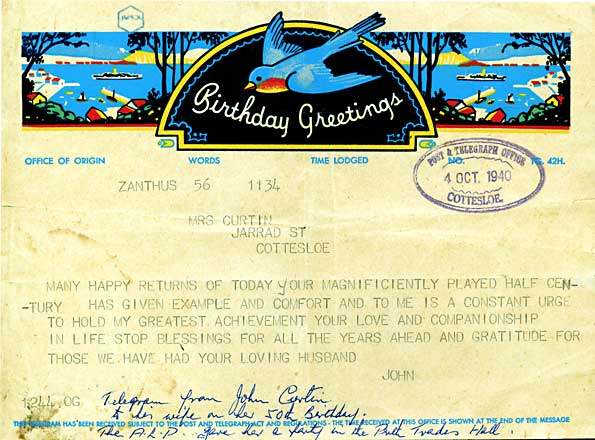Description
This is a birthday greetings telegram sent by John Curtin from Zanthus, on the Trans-Australian Railway in Western Australia, to his wife Elsie in Cottesloe, Western Australia, on 4 October 1940.
![]() Further information is available for this resource.
Further information is available for this resource.
Educational value
- This asset is an example of a greetings telegram from the 1940s - the colourful header features a gliding bird against a view of ships in a harbour framed by silhouetted trees.
- It suggests the close and loving relationship between John Curtin (1885-1945, Prime Minister of Australia 1941-45) and Elsie Curtin (1890-1975) - in this birthday telegram, Curtin writes that Elsie's 'LOVE AND COMPANIONSHIP' is his 'GREATEST ACHIEVEMENT' and ends with the words: 'BLESSINGS FOR ALL THE YEARS AHEAD AND GRATITUDE FOR THOSE WE HAVE HAD YOUR LOVING HUSBAND JOHN'.
- It reveals a little of John Curtin's sense of humour and his keen interest in cricket - Curtin refers to Elsie's 50 years of life as her 'MAGNIFICIENTLY [sic] PLAYED HALF CEN-TURY', using a cricketing analogy that both of them would appreciate; during his younger days in Victoria, Curtin played grade cricket with Brunswick where he was described as 'a useful bat', and later in Western Australia he played for the Cottesloe Cricket Club, although not in the first-grade cricket competition.
- It reveals that Australian parliamentarians often endure separation from their families - John Curtin sent the telegram to his wife from Zanthus (about 650 kilometres east of Perth) as he was travelling home to Cottesloe, Western Australia; Elsie was being given a fiftieth birthday party by the Labor Women's Organisation, which Curtin was to attend, but he had been delayed in Canberra and was only halfway across the Nullarbor on the Trans-Australian Railway on the day of her birthday; Curtin spent long periods in Canberra once he entered parliament in 1928 and especially when he became Leader of the Opposition (1935) and then Prime Minister (1941-45).
- It indicates that Zanthus, located on the Nullarbor Plain between Kalgoorlie and Rawlinna, was at the time one of the stations on the Trans-Australian Railway - steam trains often stopped at Zanthus to take on water; the journey by rail between Melbourne and Perth took three-and-a-half days and, due to different railway gauges, involved several changes of train; the Trans-Australian Railway became the main route for the movement of Australian troops during the Second World War.
- It is an example of a telegram from the 1940s - in this era, telephones were not commonplace in private homes and communication options such as mobile phones and email had not yet been invented; telegrams could be rapidly transmitted and were commonly used for urgent communications or to send messages on special occasions such as birthdays, weddings and Christmas; the postal service hand-delivered telegrams to private homes and businesses, but the telegram service ended in the late 1980s due to rising costs, the almost universal spread of telephones and cheaper long-distance telephone calls.
